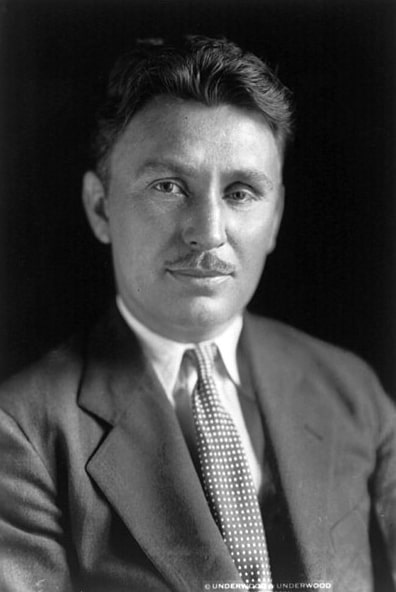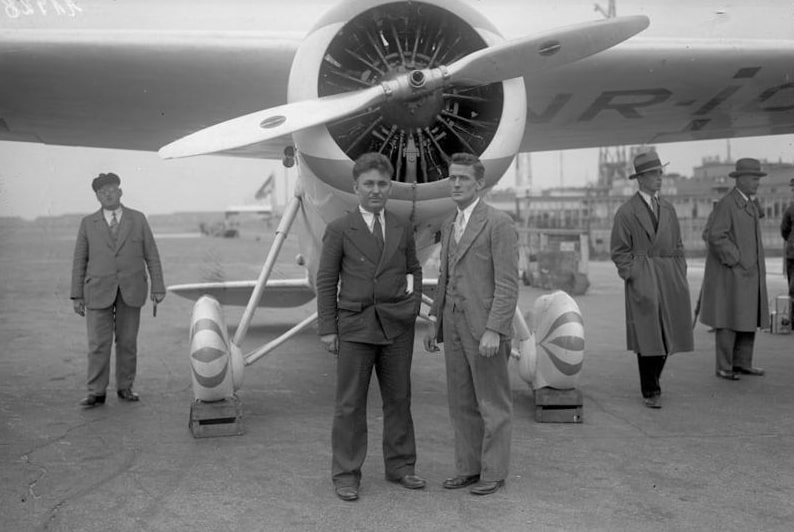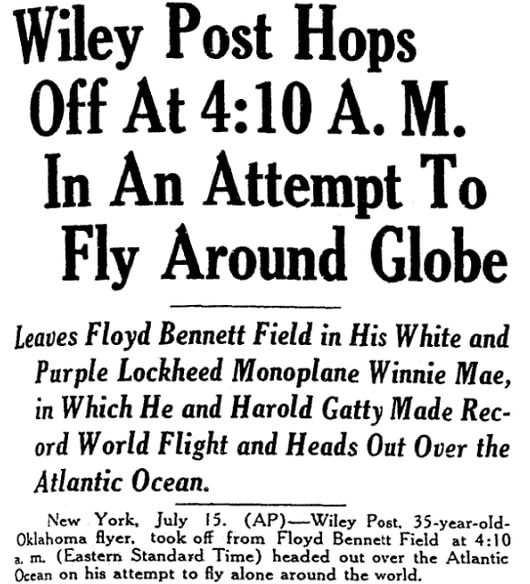The 1920s and 1930s were an exhilarating era for aviation. Improvements in airplane design and equipment led to new speed and distance records continually being set. The world was thrilled in May 1927 when Charles Lindbergh became the first person to fly solo across the Atlantic Ocean – a feat matched five years later, when Amelia Earhart became the first woman to fly solo across the Atlantic, in May 1932.

In 1931, another daring pilot, Wiley Post – along with his navigator, Harold Gatty – became the first to fly a single-engine monoplane around the world, traveling 15,474 miles in 8 days and 15 hours and 51 minutes. They flew in Post’s airplane the Winnie Mae.

Not content with that feat, Post installed some new equipment to the Winnie Mae – an autopilot device and a radio direction finder – and on 15 July 1933 took off for his grandest adventure: the first solo flight around the world! He was successful, accomplishing the flight in 7 days, 18 hours, 49 minutes.
Newspapers supplied all the details of Post’s solo flight to their eager readers.

Here is a transcription of this article:
Wiley Post Hops Off at 4:10 A.M. in an Attempt to Fly around Globe
Leaves Floyd Bennett Field in His White and Purple Lockheed Monoplane Winnie Mae, in Which He and Harold Gatty Made Record World Flight, and Heads Out over the Atlantic Ocean
New York, July 15. (AP) – Wiley Post, 35-year-old Oklahoma flyer, took off from Floyd Bennett Field at 4:10 a.m. (Eastern Standard Time) headed out over the Atlantic Ocean on his attempt to fly alone around the world.
He was flying the white and purple Lockheed monoplane Winnie Mae in which he and Harold Gatty made their round-the-world record of 8 days, 15 hours, 51 minutes in 1931. This time, he hopes to do it faster.
“I’ll be back as quick as possible,” he shouted.
Only two bad spots of weather were reported ahead of him on the first leg of his trip, the 3,900 miles to Berlin. There was a low pressure area off the Atlantic coast near New York, which he intended to fly around, and rain off the coast of Ireland, which he plans to fly through.
Attains Altitude
The heavily loaded Winnie Mae ran the length of the runway before she got into the air. Post bounced the ship once trying to get it off the ground, but when it finally did rise he gained altitude rapidly and headed straight into a clear red sunrise.
He expected the Winnie Mae’s cruising speed of 170 miles an hour to be increased at least 25 miles by a strong supporting west wind. The airplane has a top speed of 210 miles an hour.
Although Post flies alone, he will have the aid of a robot assistant pilot, a mechanical apparatus designed to keep the plane on its course and maintain its altitude and lateral stability.
Arrived at Field
Post arrived at the field about midnight, curled up on a cot, and slept, preparatory to the take-off. He was dressed in a new grey suit, was bareheaded, and wore a white patch over his left eye, the eye which he lost in 1926 on an oil well job. Two years ago, on his round-the-world trip, his glass eye irritated him so that he decided to abandon it this year.
He signed the pilots’ register: “Wiley Post. From – Floyd Bennett Field. Destination – Same.”
While Post slept, the Winnie Mae, already out on the 4,100-foot runway, was fueled. The tanks were filled with 650 gallons of gasoline and 25 gallons of oil.
The flyer carries probably the most elaborate equipment ever to be placed aboard an airplane. It includes:
His food – One quart of water, one quart of tomato juice, one box of hard toast, three packages of chewing gum.
Personal necessities – Extra shirts, ties, underwear and razor, boric acid, raincoat, three eye patches.
Aeronautical necessities – Maps, passports, wireless guide, hand crank, compass compensation chart, five cans Ethyl fluid, special monocular, nine pounds grease and a grease gun, five spare wireless tubes, 18 spare spark plugs, fishing line and hooks, cigarette lighter, mosquito net, sleeping bag, generative flashlight.
Other Possessions
Two other prized possessions are included. They are a trick parachute, which he won’t wear but can slip on in a hurry in case of an emergency, and an Indian tomahawk, for defense.
Post is guided on his transatlantic flight by wireless station G2LO of Manchester, England, which will give him regular directional and weather reports. The Winnie Mae is equipped with a radio receiving set only.
The flyer was in rare good humor at starting time, partly because Clyde Pangborn, transpacific flyer, presented him a medal which Pangborn had received from Count Felix von Luckner, the famous German war raider.
About 200 persons, mostly flyers, were assembled to witness the take-off.
Note: An online collection of newspapers, such as GenealogyBank’s Historical Newspaper Archives, is not only a great way to learn about the lives of your ancestors – the old newspaper articles also help you understand American history and the times your ancestors lived in, and the news they talked about and read in their local papers.
Related Articles:
